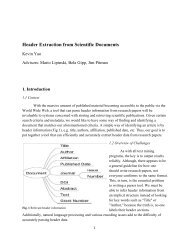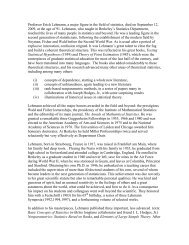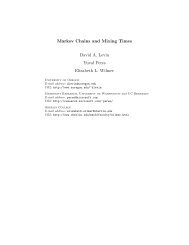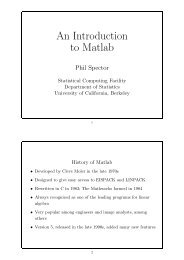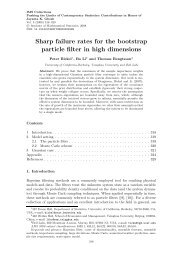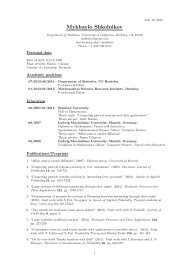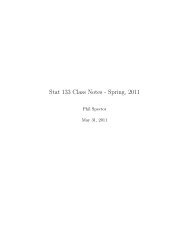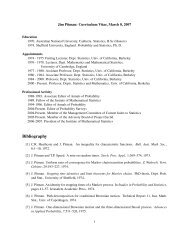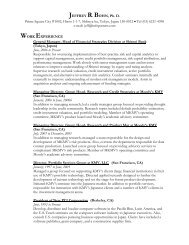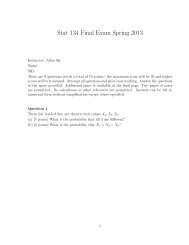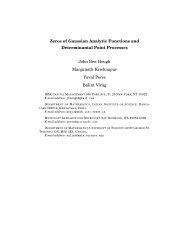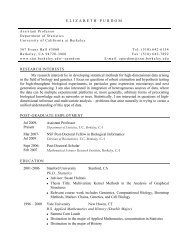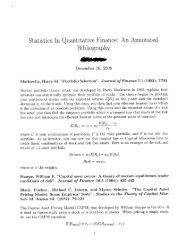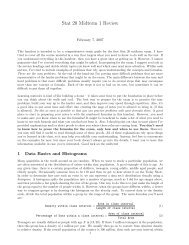WALD III SOFTWARE FOR THE MASSES (AND AN ... - Statistics
WALD III SOFTWARE FOR THE MASSES (AND AN ... - Statistics
WALD III SOFTWARE FOR THE MASSES (AND AN ... - Statistics
You also want an ePaper? Increase the reach of your titles
YUMPU automatically turns print PDFs into web optimized ePapers that Google loves.
<strong>WALD</strong> <strong>III</strong><br />
<strong>SOFTWARE</strong> <strong>FOR</strong> <strong>THE</strong> <strong>MASSES</strong><br />
(<strong><strong>AN</strong>D</strong> <strong>AN</strong> EXAMPLE)<br />
Leo Breiman<br />
UCB <strong>Statistics</strong><br />
leo@stat.berkeley.edu<br />
1
IS <strong>THE</strong>RE <strong>AN</strong> OBLIGATION?<br />
Tens of thousands of statisticians around the<br />
world are using statistical packages to arrive<br />
at conclusions-SAS, SPSS, STATA , etc.<br />
These packages are filled with a lot of<br />
obsolete crank-it-out procedures, and very<br />
few up-to-date methods (except Matlab<br />
which is expensive and not in common use).<br />
The statisticians using these packages are the<br />
very large majority in the statistical<br />
profession.<br />
WHAT OBLIGATION DOES ACADEMIC<br />
STATISTICS HAVE TO PROVIDE <strong>THE</strong><br />
FIELD WITH USEFUL, MODERN<br />
<strong>SOFTWARE</strong>?<br />
(PREFERABLY FREE--KUDOS TO R)<br />
2
A PERSONAL VIEW<br />
My answer is personal--I think we have to<br />
close the great gap in statistics today<br />
between theory and practice.<br />
We need to develop good software tools<br />
that can help the practice of statistics out in<br />
the field: the technology transfer from<br />
academic statistics to the field needs to be<br />
greatly increased.<br />
An excellent example of the merging of<br />
theory and practice is wavelets, but there are<br />
few such examples.<br />
The pivotal tool is developing software is the<br />
ability to do it.<br />
Therefore, I have a radical proposal:<br />
That every Ph.D. graduate in statistics be<br />
required to have a good working knowledge<br />
of art least one higher level language--<br />
C, ,JAVA or Fortran 90.<br />
My plan for myself is to put more working<br />
software on my web site for free. The<br />
following discusses my next effort.<br />
3
A LESSON FROM <strong>THE</strong> PAST<br />
Three decades ago many statisticians and<br />
quantitative social scientists were enamored<br />
of multilinear regression and its theory of<br />
hypothesis testing on the coefficients.<br />
Every statistical package had a regression<br />
program variable selection program based<br />
on F-to delete and F to enter.<br />
It was almost impossible to get a paper<br />
published unless you showed that a certain<br />
coefficient was signifigant at the 5% level.<br />
This was regardless of how well the linear<br />
model fit the data and little effort was made<br />
to find out.<br />
Many conclusions were undoubtedly wrong,<br />
and I don't think statisticians now-a-days<br />
dispute the error of these ways.<br />
4
ENTER <strong>THE</strong> COX MODEL<br />
In the last decade or two, the Cox model for<br />
that analysis of survival data has come to<br />
occupy the place in the medical field that<br />
multilinear regression once had in the social<br />
science.<br />
A method for fitting the Cox model appears<br />
in every statistical package under the sun.<br />
My friend and biostatistician Richard Olshen<br />
tells me that use of the Cox model is the<br />
requirement for publication in some medical<br />
journals.<br />
When I voiced my concerns to well-known<br />
biostatisticians over the last few years, the<br />
response was "well, the data is too weak to<br />
do anything else".<br />
I considered this a challenge to create a<br />
better method.<br />
5
SURVIVAL <strong>AN</strong>ALYSIS<br />
Data from a survival experiment are of the<br />
form:<br />
(c n ,t n ,x n ), n = 1,...,N}<br />
Here, c n =1 if the nth case died during the<br />
duration of the experiment and 0 if it was<br />
censored by dropping out during the course<br />
of the experiment or lasting until the end.<br />
The t n is the time of death or censoring, and<br />
x n is a vector of covariates.<br />
The goal of survival analysis is to trace the<br />
effects of the covariates on the times of<br />
death.<br />
6
HAZARD <strong><strong>AN</strong>D</strong> SURVIVAL<br />
Given a random death time T(x) depending<br />
on the covariate vector, define the hazard<br />
function by:<br />
h(t,x) = P(T(x) ∈(t + dt,t)|T(x) ≥ t)/dt<br />
and the survival function:<br />
S(t,x) = P(T(x) ≥ t) = exp(− ∫ h(τ,x )dτ)<br />
The Cox model makes the assumption that<br />
h(t,x) = r(t)exp(β • x)<br />
and then makes a clever partial likelihood<br />
jump that allows the r(t) to be canceled out<br />
in the estimation of β . One result is that all<br />
survival curves have the same shape.<br />
Can this possibly represent the complex action of<br />
nature even as a first approximation?<br />
t<br />
0<br />
7
THREE SIMULATED DATA SETS<br />
Its useful when testing new methods to<br />
generate simulated data where truth is<br />
known.<br />
Sim1. This is 300 case data with five<br />
uniformly distributed covariates, 19%<br />
censoring, generated from a Cox model<br />
where the hazard function is:<br />
h(t,x) = exp(x 1 − 2x 4 + 2x 5 )<br />
Sim2 This 300 case data with three<br />
uniformly distributed covariates, 15%<br />
censoring, has hazard function::<br />
if x 1 ≤.5, h(t,x) = 0 if .5≤ t ≤ 2.5, else exp(x 2 )<br />
if x 1 >.5, h(t,x) = 0 if 2.5 ≤ t ≤ 4.5, else exp(x 3 )<br />
Sim3 This 300 case data set with six<br />
uniformly distributed covariates, 29%<br />
censoring, has hazard function:<br />
h(t,x) = (1 + z 2 t)exp*(z 1 + z 2 t)<br />
where z 1 =.5x 1 , z 2 =x 4 +x 5<br />
8
1<br />
.5<br />
0<br />
1<br />
.5<br />
1<br />
.5<br />
0<br />
0<br />
SIM1 SURVIVAL CURVES<br />
0 1 2 3<br />
SIM2 SURVIVAL CURVES<br />
0 1 2 3 4 5 6 7<br />
SIM3 SURVIVAL CURVES<br />
0 .5 1<br />
9
INTRODUCING SURVIVAL <strong>FOR</strong>ESTS (SF)<br />
I am developing a method (survival forests<br />
(SF)) for estimating the survival functions<br />
S(t,x) At present it is still in the experimental<br />
stage<br />
These functions can also be estimated using<br />
the Cox model by first estimating coefficients<br />
and then doing an ml estimate of r(t).<br />
With simulated data the true survival<br />
functions S*(t,x) are known.<br />
Define the error in the estimates as:<br />
error = av k,n |S(t k ,x n ) − S *(t k ,x n )|<br />
where the {t k } are the uncensored death<br />
times<br />
Errors<br />
data set Cox SF<br />
Sim1 .054 .066<br />
Sim2 .135 .100<br />
Sim3 .572 .068<br />
10
FOUR REAL DATA SETS<br />
Simulated data may not reflect the vagaries<br />
of real data. I have been working with four<br />
real data sets.<br />
Bcan: this is a breast cancer data set sent to<br />
me from England. It has 272 cases, 6<br />
covariates and 17% censoring.<br />
Vcan: a veterans cancer data set with 136<br />
cases, 6 covariates and 7% censoring.<br />
UIS: a return to drugs data set with 575<br />
cases, 8 covariates and 19% censoring. (see<br />
the book "Applied Survival Analysis" by<br />
Hosmer and Lemeshow)<br />
Gcan: the German cancer study with 686<br />
cases, 7 covariates, and 56% censoring.<br />
11
ARE SIMULATED <strong><strong>AN</strong>D</strong> REAL<br />
COMPARABLE<br />
Do the real data sets have as much<br />
information in them as the simulated?<br />
In SF there is a test set method for estimating<br />
the times of death--estimating td(n) by ˆtd(n).<br />
Measure the error in this estimate by:<br />
error = av n (|td(n) − ˆtd(n)| / ˆtd(n))<br />
and the strength of the data by 100(1-error).<br />
If the error is high the strength is low.<br />
Data Set Strength<br />
Sim1 19.5<br />
Sim2 13.5<br />
Sim3 32.0<br />
Bcan 27.4<br />
Vcan 18.9<br />
UIS 35.5<br />
Gcan 45.2<br />
The real data sets have, on average, more<br />
strength than the simulated. Strength is an<br />
indicator of how well the survival functions<br />
are estimated. Note that the lowest strength<br />
simulated data set Sim2 also had the highest<br />
error in estimating these functions.<br />
12
CORRELATIONS OVER TIME<br />
There are three methods (so far) for using SF<br />
to look at the time process in the data. The<br />
first method is time-varying correlations. We<br />
work with<br />
L(t,x) =−log(S(t,x))<br />
Take the time points {t k } to be 100 order<br />
statistics from the uncensored death times.<br />
At each t k compute the correlation between<br />
L(t k , x n ) and each of the covariates. If a Cox<br />
model fits the data, these correlations should<br />
be constant in time.<br />
Graphs of the corelations follow.<br />
13
1<br />
.5<br />
0<br />
-.5<br />
-1<br />
.5<br />
-.5<br />
1<br />
.5<br />
0<br />
1<br />
0<br />
SIM 1 CORRELATIONS<br />
0 1 2 3<br />
SIM 2 CORRELATIONS<br />
0 1 2 3 4 5 6 7<br />
SIM 3 CORRELATIONS<br />
0 .25 .5 .75 1<br />
X1<br />
X2<br />
X3<br />
X4<br />
X5<br />
X1<br />
X2<br />
X3<br />
X1<br />
X2<br />
X3<br />
X4<br />
X5<br />
X6<br />
14
.6<br />
.2<br />
-.2<br />
1<br />
.5<br />
0<br />
-.5<br />
-1<br />
1<br />
BC<strong>AN</strong> CORRELATIONS<br />
0 10 20 30<br />
VC<strong>AN</strong> CORRELATIONS<br />
0 250 500 750 1000<br />
X1<br />
X2<br />
X3<br />
X4<br />
X5<br />
X6<br />
X1<br />
X2<br />
X3<br />
X4<br />
X5<br />
X6<br />
15
1<br />
.5<br />
0<br />
-.5<br />
1<br />
.5<br />
0<br />
-.5<br />
UIS CORRELATIONS<br />
0 100 200 300 400 500 600 700<br />
GC<strong>AN</strong> CORRELATIONS<br />
0 500 1000 1500 2000 2500<br />
X1<br />
X2<br />
X3<br />
X4<br />
X5<br />
X6<br />
X7<br />
X8<br />
X1<br />
X2<br />
X3<br />
X4<br />
X5<br />
X6<br />
X7<br />
16
TIME FITTING COX MODELS<br />
Another tool that is useful is fitting a Cox<br />
model at each time t k to the L(t k , x n ) .<br />
At each t k let<br />
and<br />
y n = L(t k ,x n )<br />
f (n,t(k),β(k)) = t(k)exp(β(k)⋅ x n )<br />
The right hand side is the negative log of the<br />
Cox expression with the t(k),β(k) parameters<br />
to be determined by minimizing<br />
∑(yn − f (n,t(k),β(k)))<br />
n<br />
2<br />
If the Cox model is a good fit, the β(k) will ce<br />
constant in time and the t(k)} are an<br />
estimate of the integral of the baseline risk.<br />
Again, we show some graphs:<br />
17
2.5<br />
1.5<br />
.5<br />
-.5<br />
-1.5<br />
-2.5<br />
2<br />
1.5<br />
1<br />
.5<br />
0<br />
-.5<br />
-1<br />
.5<br />
.3<br />
.1<br />
-.1<br />
SIM 1 COEFFICIENT TRACES AV RSQ=.84<br />
0 1 2 3<br />
SIM 2 COEFFICIENT TRACES AV RSQ=.33<br />
0 1 2 3 4 5 6 7<br />
SIM 3 COEFFICIENT TRACES AV RSQ=.62<br />
0 .2 .4 .6 .8<br />
X1<br />
X2<br />
X3<br />
X4<br />
X5<br />
X1<br />
X2<br />
X3<br />
X1<br />
X2<br />
X3<br />
X4<br />
X5<br />
X6<br />
18
3.5<br />
2.5<br />
1.5<br />
.5<br />
-.5<br />
1<br />
0<br />
-1<br />
-2<br />
-3<br />
BC<strong>AN</strong> COEFFICIENT TRACES AV RSQ=.70<br />
0 5 10 15 20 25 30<br />
VC<strong>AN</strong> COEFFICIENT TRACES AV RSQ=.78<br />
0 200 400 600 800 1000<br />
X1<br />
X2<br />
X3<br />
X4<br />
X5<br />
X6<br />
X1<br />
X2<br />
X3<br />
X4<br />
X5<br />
X6<br />
19
.6<br />
.3<br />
0<br />
-.3<br />
-.6<br />
2<br />
0<br />
-2<br />
-4<br />
-6<br />
-8<br />
-10<br />
UIS COEFFICIENT TRACES AV RSQ=.48<br />
0 100 200 300 400 500 600<br />
GC<strong>AN</strong> COEFFICIENT TRACES AV RSQ=.44<br />
0 500 1000 1500 2000<br />
X1<br />
X2<br />
X3<br />
X4<br />
X5<br />
X6<br />
X7<br />
X8<br />
X1<br />
X2<br />
X3<br />
X4<br />
X5<br />
X6<br />
X7<br />
20
END NOTE ON APPLICATIONS<br />
When there are changes in time over the<br />
duration of the experiment, the Cox model<br />
gives dubious results.<br />
For instance, in the UIS data the Cox model<br />
singles out the significant variables (in order)<br />
as X1>X4>X7 and no others significant at the<br />
.05 level.<br />
Examination of the correlations in time and<br />
the coefficient traces for the UIS data shows<br />
that there are three important variables<br />
XI,X2,X5.<br />
The Cox model may be dangerous to the<br />
medical experimental profession.<br />
21
HOW SV WORKS<br />
Building a Survival Tree<br />
With fixed covariate effects and random<br />
censoring, the log likelihood can be expressed in<br />
terms of the hazard function h(t,x)as<br />
LL = ∑ cn log[h(tn ,xn ) ] − ∑ ∫ h(τ,x n ) dτ<br />
This expression is our starting point. The tree<br />
will be grown to maximize it.<br />
Divide the time-covariate space into a union of L<br />
disjoint rectangles indexed by l. Call these nodes.<br />
Use the notation l=I l ⊗R l where I l is a time interval<br />
and R l is a rectangle in covariate space.<br />
The essential step is to express h(t,x) as<br />
h(t,x) = exp[ ∑ I( (t,x) ∈l)α(l)]<br />
l<br />
where I is the 0,1, indicator function.<br />
0 t n<br />
22
Define (1)<br />
CONTINUED<br />
ND (l) = ∑ cnI((tn ,xn )∈l)<br />
n<br />
Then N D (l)is the number of deaths in the node l.<br />
Define also (2)<br />
T(l) = ∑ I(xn ∈Rl )|(0,t n )I Il |<br />
n<br />
where || denotes length of the enclosed interval.<br />
Substituting the expression for h(t,x), (1) and (2)<br />
into the expression for the LL, gives<br />
LL = ∑ α(l) ND (l) − ∑ T(l)exp( α(l))<br />
l<br />
l<br />
Maximizing this over the α(l) gives<br />
and<br />
α(l) = log(N D (l)/T(l))<br />
LL = ∑ ND (l) log(ND (l)/T(l)) − ∑<br />
ND (l)<br />
l<br />
l<br />
23
SPLITTING NODES<br />
The second term above is constant.<br />
At each step the split of l is found which most<br />
increases<br />
N D (l)log(N D (l)/T(l))<br />
Univariate splits on a covariate are the ordinary<br />
splits as used in CART but using the above<br />
expression to maximize.<br />
Splits on time are tricky.<br />
t(n)<br />
A case with covariate x n keeps traveling through<br />
nodes until it comes to a node such that t 1
CONTINUED<br />
To work, there have to be many splits on time.<br />
With probability .75 the split on each node is on<br />
the time variable only.<br />
With probability ,25, the split is the best split on<br />
any of the covariates.<br />
The tree is grown until each terminal node has<br />
exactly one uncensored death in it. But terminal<br />
nodes can contain many other cases.<br />
25
GROWING <strong>THE</strong> <strong>FOR</strong>EST<br />
Each tree in the forest is grown on a bootstrap<br />
sample from the original training set. Again, about<br />
one-third of the cases are oob.<br />
Let x be the covariate vector of an oob case. Put<br />
it down the corresponding tree and estmate S(t,x)<br />
by:<br />
log(S(t,x)) =− ∑[N D (l)/T(l)] I(x ∈Rl )|(0,t)I Il |<br />
l<br />
where the sum is over all terminal nodes.<br />
This estimate is accumulated and averaged every<br />
time x is not in the tree growing sample.<br />
The averaged survival function, estimated for<br />
cases in the data not used in the corresponding<br />
tree, is automatically a test set estimate.<br />
26
TYING UP A LOOSE END WITH SCALING<br />
As in RF, proximities can be defined by of<br />
often two cases occupy the same terminal<br />
node, although there is a different definition<br />
for terminal nodes in SF.<br />
They can also be projected down into two<br />
dimensions. Recall, we have not yet solved<br />
the problem of how to recognize the action<br />
of the switch variable in Sim2.<br />
Here is a graph of the 2nd scaling coordinate<br />
versus the first for sim 2.<br />
COORDINATE 2<br />
.1<br />
0<br />
-.1<br />
SCALING COORDINATE PLOT<br />
-.2<br />
-.25 -.15 -.05 .05 .15<br />
COORDINATE 1<br />
27
AHA!<br />
Noting that it looked symmetric above and<br />
below the zero of 2nd coordinate, I<br />
constructed the histograms of x1 above and<br />
below this zero point.<br />
Count<br />
Count<br />
25<br />
20<br />
15<br />
10<br />
5<br />
0<br />
20<br />
15<br />
10<br />
5<br />
0<br />
HISTOGRAM OF X1--COOR. 2 >0<br />
0 .1 .2 .3<br />
X1 values<br />
.4 .5<br />
0 .1 .2 .3 .4 .5<br />
XI VALUES<br />
AHA! A CLUE<br />
HISTOGRAM OF X1 --COOR 2
FINAL REMARKS<br />
RF has been extensively tested in the field.<br />
SV is still being born and needs more testing,<br />
working with, and extending.<br />
But it may prove the point that algorithmic<br />
models can provide more (and more reliable)<br />
information than stochastic models.<br />
As soon as it is in decent shape, SV will show<br />
up on my web site as free software for use<br />
by the masses.<br />
TH<strong>AN</strong>K YOU<br />
29



